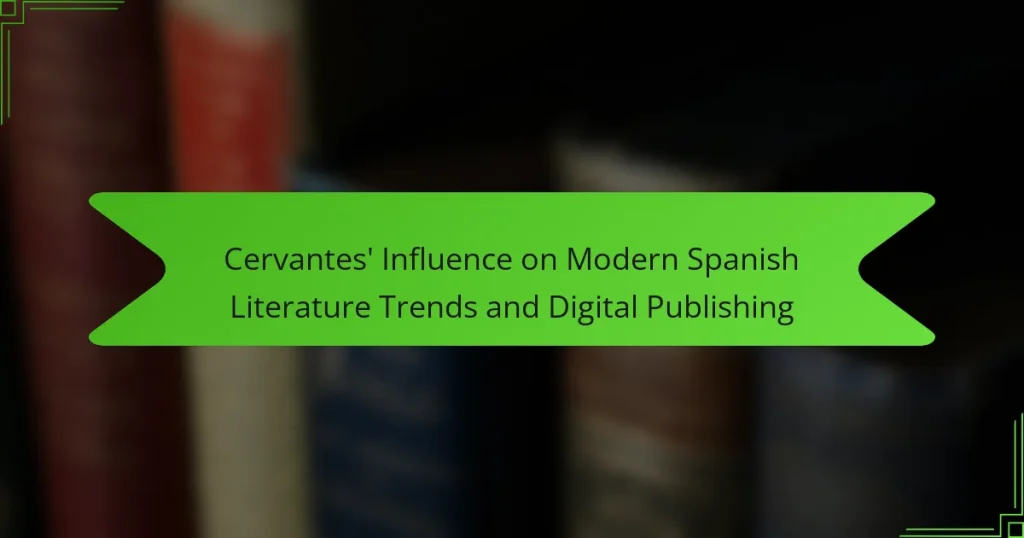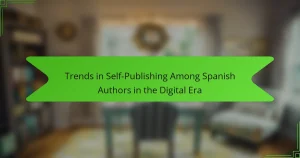Cervantes’ influence on modern Spanish literature is profound, impacting narrative techniques, character development, and digital publishing trends. His innovative use of metafiction and complex characters reshaped storytelling, prompting contemporary authors to explore themes of identity and reality. Digital platforms enhance access to his works, allowing new interpretations that reflect ongoing societal challenges. Regional differences also shape how Cervantes’ legacy is perceived and adapted in various cultural contexts.

How did Cervantes shape the narrative techniques in modern Spanish literature?
Cervantes significantly influenced modern Spanish literature through innovative narrative techniques. His use of metafiction and diverse perspectives reshaped storytelling. For instance, “Don Quixote” introduced unreliable narration, prompting authors to explore character consciousness and subjective realities. This approach laid the groundwork for contemporary narrative forms, enhancing engagement in digital publishing. Cervantes’ blending of genres and humor created a rich tapestry that continues to inspire writers today, demonstrating the lasting impact of his unique attributes on literature.
What are the key narrative styles influenced by Cervantes?
Cervantes significantly influenced narrative styles in modern Spanish literature through his innovative use of metafiction and character development. His work introduced a self-aware narrative that challenges the boundaries between fiction and reality. This approach paved the way for future authors to explore complex themes and unreliable narrators. Additionally, Cervantes’ blending of humor and tragedy in storytelling has shaped contemporary narratives, encouraging a more nuanced portrayal of characters and situations. His impact is evident in the evolution of literary techniques that prioritize psychological depth and social commentary in modern writing.
Which contemporary authors draw inspiration from Cervantes’ works?
Contemporary authors such as Javier Marías, Carlos Ruiz Zafón, and Enrique Vila-Matas draw inspiration from Cervantes’ works. Their narratives often reflect themes of identity, illusion, and the human condition, echoing Cervantes’ influence on modern Spanish literature trends. Marías explores existential questions, while Ruiz Zafón incorporates elements of magical realism. Vila-Matas engages with metafiction, showcasing Cervantes’ lasting impact on storytelling in digital publishing.

What impact did Cervantes have on character development in literature?
Cervantes significantly impacted character development in literature by introducing complex, multi-dimensional characters. His work, particularly “Don Quixote,” showcased the psychological depth and moral ambiguity of characters, influencing modern Spanish literature trends. This shift towards realistic character portrayal paved the way for subsequent literary movements and digital publishing practices that emphasize character-driven narratives. Cervantes’ unique approach to character development remains a cornerstone of literary analysis, shaping how authors construct their protagonists and antagonists today.
How do modern characters reflect Cervantes’ archetypes?
Modern characters reflect Cervantes’ archetypes through their complexity and moral ambiguity. Contemporary Spanish literature often draws on Cervantes’ themes of identity, illusion versus reality, and the human condition. Characters like those in recent novels exhibit traits of both heroism and flaw, mirroring Cervantes’ nuanced portrayals. Additionally, digital publishing allows for diverse interpretations of these archetypes, enabling authors to explore and challenge traditional narratives. This evolution signifies Cervantes’ lasting impact on character development and thematic exploration in modern storytelling.
What are the psychological complexities in characters inspired by Cervantes?
Cervantes’ characters exhibit profound psychological complexities that influence modern Spanish literature. His exploration of identity, duality, and existential struggles resonates in contemporary narratives. Characters like Don Quixote embody idealism clashing with reality, showcasing internal conflicts that inspire modern writers. This legacy enhances digital publishing trends, fostering deeper character studies and interactive storytelling that reflect these complexities.

How has Cervantes’ work influenced themes in contemporary Spanish literature?
Cervantes’ work profoundly influences contemporary Spanish literature, particularly in narrative structure and character development. His innovative use of metafiction and complex characters has inspired modern authors to explore themes of identity and reality. For example, the blending of fiction and reality in current digital narratives often traces back to Cervantes’ techniques. Additionally, his exploration of social issues resonates in today’s literature, reflecting ongoing societal challenges. The rise of digital publishing has further expanded access to Cervantes’ influence, allowing new voices to reinterpret his themes in innovative ways.
Which themes from Cervantes are prevalent in modern narratives?
Cervantes’ themes of identity, illusion versus reality, and social critique are prevalent in modern narratives. His exploration of the human condition influences contemporary storytelling, especially in Spanish literature and digital publishing.
Identity is a central theme in works like “Don Quixote,” where characters grapple with their roles and perceptions. This exploration resonates in modern narratives that examine personal and cultural identities, reflecting diverse experiences and backgrounds.
The illusion versus reality theme remains significant. Cervantes’ characters often navigate a world where truth is subjective. This concept is echoed in today’s literature, where unreliable narrators and fragmented realities challenge readers’ perceptions.
Social critique is another enduring theme. Cervantes highlighted societal flaws and human follies, a practice mirrored in modern narratives that address contemporary issues such as inequality, corruption, and moral dilemmas. This critical lens encourages readers to reflect on their own societies, maintaining Cervantes’ legacy in literature.
How do cultural contexts shape the interpretation of Cervantes’ themes today?
Cultural contexts significantly influence the interpretation of Cervantes’ themes today by shaping reader perspectives. Modern Spanish literature trends reflect a blend of traditional and contemporary values, emphasizing themes of identity and societal critique. Digital publishing further democratizes access to Cervantes’ works, allowing diverse interpretations. The unique attribute of Cervantes’ narrative style encourages dialogue across cultures, enhancing relevance in today’s globalized world. As a result, his themes resonate with contemporary issues, fostering a deeper understanding of human experience.

What role does digital publishing play in preserving Cervantes’ legacy?
Digital publishing plays a crucial role in preserving Cervantes’ legacy by making his works accessible to a global audience. It facilitates the dissemination of his literature, ensuring that new generations can engage with his themes and styles. Digital platforms enable interactive experiences, enhancing reader engagement with Cervantes’ narratives. Additionally, digital archiving preserves original manuscripts and critical analyses, safeguarding his contributions to Spanish literature. This accessibility fosters a deeper understanding of Cervantes’ influence on modern literary trends, reinforcing his relevance in contemporary discussions.
How are Cervantes’ works being adapted for digital formats?
Cervantes’ works are being adapted for digital formats through interactive e-books and multimedia applications. These adaptations enhance reader engagement by incorporating audio, visual elements, and gamification. Digital platforms allow for wider accessibility, reaching diverse audiences globally. For instance, adaptations of “Don Quixote” include animated versions and interactive storytelling, making classic literature more relatable to modern readers.
What platforms are most effective for sharing Cervantes’ influence in the digital age?
Social media platforms, blogs, and digital publishing sites are most effective for sharing Cervantes’ influence today. These channels facilitate discussions, promote literary analysis, and allow for creative reinterpretations of his works. Social media, particularly Twitter and Instagram, provides immediacy and engagement, while blogs offer in-depth exploration of themes. Digital publishing platforms like Amazon Kindle and Wattpad enable wider distribution of modern adaptations and scholarly works, reaching diverse audiences. Online literary communities further amplify Cervantes’ relevance, fostering collaboration and innovation in contemporary literature.

Which unique attributes of Cervantes’ writing style are reflected in modern literature?
Cervantes’ unique attributes, such as metafiction and character complexity, significantly influence modern literature. His use of unreliable narrators invites readers to question reality, a technique prevalent in contemporary works. Additionally, character depth and moral ambiguity in Cervantes’ writing resonate in today’s narratives, enhancing emotional engagement. These elements shape trends in digital publishing, where interactive storytelling thrives.
How do modern authors reinterpret Cervantes’ humor and irony?
Modern authors reinterpret Cervantes’ humor and irony by infusing contemporary themes and diverse narrative techniques. His use of metafiction and playful irony inspires writers to experiment with self-referential storytelling. For instance, the blending of humor with social critique allows modern works to address current societal issues while maintaining a light-hearted tone. This reinterpretation reflects a unique attribute of Cervantes’ influence, as his humor remains relevant across generations. As a result, digital publishing platforms amplify these reinterpretations, reaching wider audiences and fostering new literary trends.
What rare literary techniques from Cervantes are being revived today?
Cervantes’ rare literary techniques, such as metafiction and unreliable narration, are being revived in modern Spanish literature and digital publishing. These techniques enhance narrative complexity and engage readers in new ways. Contemporary authors incorporate these methods to challenge traditional storytelling and reflect on the nature of fiction. For instance, the use of self-referential elements allows for deeper exploration of character motivations and societal critiques. As a result, Cervantes’ influence continues to shape innovative literary trends today.

How do regional differences affect the interpretation of Cervantes’ influence?
Regional differences significantly shape the interpretation of Cervantes’ influence on modern Spanish literature and digital publishing. These variations stem from cultural, historical, and linguistic contexts that affect how his works are perceived and adapted.
In Spain, Cervantes is often viewed through a lens of national pride, emphasizing his role in the Spanish Golden Age and its literary legacy. This perspective influences contemporary writers to draw on his themes of identity and social critique. In contrast, Latin American regions may interpret his influence differently, focusing on post-colonial themes and the complexities of cultural identity.
Digital publishing trends reflect these regional interpretations, with Spanish authors often engaging in traditional forms of storytelling, while Latin American writers explore innovative digital formats. This divergence highlights unique attributes of Cervantes’ influence, illustrating how modern adaptations can vary widely based on regional contexts.
As a result, understanding these regional differences is essential for appreciating Cervantes’ lasting impact on literature, as they reveal the diverse ways his work continues to resonate across cultures.
What variations exist in the reception of Cervantes across Spanish-speaking countries?
Cervantes’ reception varies significantly across Spanish-speaking countries due to cultural, historical, and literary contexts. In Mexico, his influence shapes modern narratives, while in Argentina, he inspires avant-garde movements. Spain often emphasizes his role in the Golden Age, whereas in Colombia, his work is integrated into discussions on identity. Chilean literature reflects a critical engagement with his themes, while Peru showcases adaptations in contemporary storytelling. Each country’s unique literary landscape influences how Cervantes is interpreted and celebrated.
How do digital platforms cater to diverse interpretations of Cervantes?
Digital platforms address diverse interpretations of Cervantes by promoting varied adaptations and analyses of his works. They facilitate accessibility, allowing readers to engage with different perspectives on his literature. Online forums and social media enable discussions that highlight unique cultural contexts. Digital publishing provides platforms for new voices to reinterpret Cervantes, enriching modern Spanish literature trends. These platforms also support multimedia formats, enhancing engagement through visual and auditory experiences tied to his narratives.
What are the challenges faced in translating Cervantes’ works for modern audiences?
Translating Cervantes’ works for modern audiences faces several challenges. These include cultural context, language evolution, and stylistic nuances. Modern readers may struggle to grasp the historical references and societal norms present in Cervantes’ time. Additionally, the Spanish language has evolved, making some original phrases and idioms difficult to translate accurately. Translators must balance maintaining the author’s voice with making the text accessible. The unique attributes of Cervantes’ literary style, such as his use of irony and complex characterizations, further complicate translation efforts. As a result, capturing the essence of his work while appealing to contemporary sensibilities remains a significant challenge.
What best practices can authors adopt from Cervantes to enhance their writing?
Authors can adopt several best practices from Cervantes to enhance their writing. Embrace character depth by creating multi-dimensional figures that resonate with readers. Utilize humor and irony to engage audiences, as Cervantes did with Don Quixote. Experiment with narrative structure, blending different styles and perspectives to enrich storytelling. Focus on the human experience, exploring universal themes that connect with readers emotionally. Lastly, cultivate a unique voice that reflects personal insights and cultural context, making the work distinctive and relatable.




